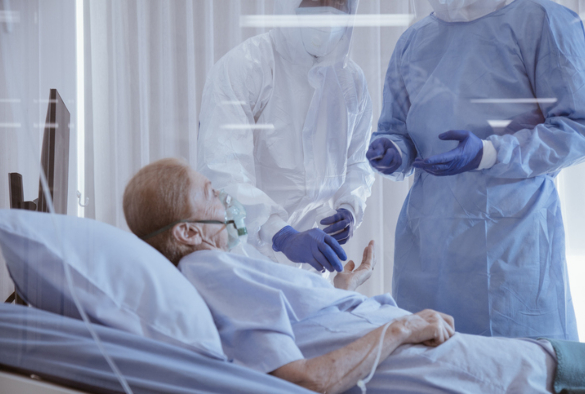
More than one in ten COVID-19 patients in 314 UK hospitals caught the infection in hospital during the first pandemic wave, a new study involving Liverpool researchers has found.
The research into UK hospital-acquired infections (HAIs) was conducted as part of the world’s largest study of severe COVID-19 and is published as a research letter in The Lancet.
Researchers examined records of COVID-19 patients in UK hospitals enrolled in the International Severe Acute Respiratory and emerging Infections Consortium (ISARIC) Clinical Characterisation Protocol UK (CCP-UK) study, who became ill before 1st August 2020.
They found that at least 11.1% of COVID-19 patients in 314 UK hospitals were infected after admission. The proportion of COVID-19 patients infected in hospital also rose to between 16% and 20% in mid-May 2020, long after the peak of admissions in the first wave.
The researchers estimate that between 5,699 and 11,862 patients admitted in the first wave were infected during their stay in hospital. They also suggest this is likely to be an underestimate, as they did not include patients who may have been infected but discharged before they could be diagnosed.
Lead author Dr Jonathan Read, University of Lancaster, said “Controlling viruses like SARS-CoV-2 (the virus that causes COVID-19) has been difficult in the past, so the situation could have been much worse. However, infection control should remain a priority in hospitals and care facilities.”
Dr Chris Green, University of Birmingham, added: “There are likely to be a number of reasons why many patients were infected in these care settings. These include the large numbers of patients admitted to hospitals with limited facilities for case isolation, limited access to rapid and reliable diagnostic testing in the early stages of the outbreak, the challenges around access to and best use of PPE, our understanding of when patients are most infectious in their illness, some misclassification of cases due to presentation with atypical symptoms, and an under-appreciation of the role of airborne transmission.”
There were marked differences in the numbers of patients infected in hospital according to the type of care provided. Hospitals providing acute and general care had lower proportions of hospital acquired infections (9.7%) than residential community care hospitals (61.9%) and mental health hospitals (67.5%), which reflects the outbreaks seen in care-homes.
Professor Calum Semple, University of Liverpool, said: “The reasons for the variation between settings that provide the same type of care requires urgent investigation to identify and promote best infection control practice. Research has now been commission to find out what was done well and what lessons need to be learned to improve patient safety.”
Dr Annemarie Docherty, University of Edinburgh, added: “The underlying reasons for these high rates of transmission in hospitals at the peak of the first wave must be investigated, so that we can improve safety and outcomes for our patients. Rates are considerably lower a year on, and people should not be deterred from attending hospital if they are unwell.”
The study was funded by National Institute for Health Research and the UK Medical Research Council. It was conducted by researchers from Lancaster University, University of Liverpool, University of Edinburgh, London School of Hygiene & Tropical Medicine, University of Birmingham, University of Glasgow, University of Oxford, Public Health England, University of Nottingham, and Imperial College London.
Research reference
Hospital-acquired SARS-CoV-2 infection in the UK’s first COVID-19 pandemic wave, The Lancet Correspondence, https://doi.org/10.1016/S0140-6736(21)01786-4